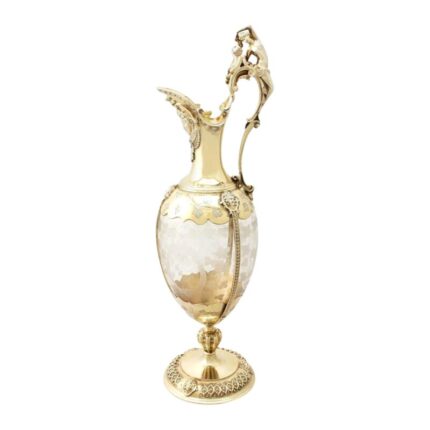The ormolu banded top with beautiful floral marquetry and outset canted corners, above two useful drawers. The canted corners with ormolu mounts and line inlay linked by a lower tier, also with superb floral marquetry decoration, that stands on slightly hipped legs that terminate in striking ormolu sabots.
Complete with working locks and key.
Add an elegant touch to any room with this lovely table.
Condition:
In excellent condition having been beautifully cleaned and French polished in our workshops, please see photos for confirmation.
Dimensions in cm:
Height 77 x width 55 x depth 37
Dimensions in inches:
Height 30.3 x width 21.7 x depth 14.6
The table en chiffonière is a type of furniture that appeared in France circa 1750, as patrons sought to combine a sense of elegance and comfort in their daily furnishings. This kind of table typically included drawers that could be used to hold papers, jewelry, and chiffons or cloth, hence the table’s name. ormolu bronze moulding around the top has been carefully made to allow the individual user to dash off small notes with comfort and ease.
Parquetry – is a geometric mosaic of wood pieces used for decorative effect. The two main uses of parquetry are as veneer patterns on furniture and block patterns for flooring. Parquetry patterns are entirely geometrical and angular, squares, triangles, lozenges.
The word derives from the Old French parchet, literally meaning “a small enclosed space”. Large diagonal squares known as parquet de Versailles were introduced in 1684 as parquet de menuiserie to replace the marble flooring that required constant washing, which tended to rot the joists beneath the floors.
Such parquets en lozange were noted by the Swedish architect Daniel Cronström at Versailles and at the Grand Trianon in 1693. Timber contrasting in color and grain, such as oak, walnut, cherry, lime, pine, maple etc. are sometimes employed; and in the more expensive kinds sometimes other tropical hardwoods are also used.
Marquetry
is decorative artistry where pieces of material (such as wood, pewter or brass silver) of different colors are inserted into surface wood veneer to form intricate patterns such as scrolls or flowers.
The technique of veneered marquetry had its inspiration in 16th century Florence. Marquetry elaborated upon Florentine techniques of inlaying solid marble slabs with designs formed of fitted marbles, jaspers and semi-precious stones. This work, called opere di commessi, has medieval parallels in Central Italian “Cosmati”-work of inlaid marble floors, altars and columns. The technique is known in English as Pietra Dura, for the “hardstones” used: onyx, jasper, cornelian, lapis lazuli and colored marbles. In Florence, the Chapel of the Medici at San Lorenzo is completely covered in a colored marble facing using this demanding jig-sawn technique.
Techniques of wood marquetry were developed in Antwerp and other Flemish centers of luxury cabinet-making during the early 16th century. The craft was imported full-blown to France after the mid-17th century, to create furniture of unprecedented luxury being made at the royal manufactory of the Gobelins, charged with providing furnishings to decorate Versailles and the other royal residences of Louis XIV. Early masters of French marquetry were the Fleming Pierre Golle and his son-in-law, André-Charles Boulle, who founded a dynasty of royal and Parisian cabinet-makers (ébénistes) and gave his name to a technique of marquetry employing brass with pewter in arabesque or intricately foliate designs.
Ormolu – (from French ‘or moulu’, signifying ground or pounded gold) is an 18th century English term for applying finely ground, high-carat gold in a mercury amalgam to an object of bronze. The mercury is driven off in a kiln leaving behind a gold-colored veneer known as ‘gilt bronze’.
The manufacture of true ormolu employs a process known as mercury-gilding or fire-gilding, in which a solution of nitrate of mercury is applied to a piece of copper, brass, or bronze, followed by the application of an amalgam of gold and mercury. The item was then exposed to extreme heat until the mercury burned off and the gold remained, adhered to the metal object.
-
Dimensions:Height: 30.32 in (77 cm)Width: 21.66 in (55 cm)Depth: 14.57 in (37 cm)
-
Materials and Techniques:Ormolu,WoodMarquetryParquetry
-
Place of Origin:France
-
Period:1870-1879
-
Date of Manufacture:circa 1870
-
Condition:Good
-
Seller Location:London, GB
-
Reference Number:Seller: A1092Seller: LU950619117092




























































Reviews
There are no reviews yet.